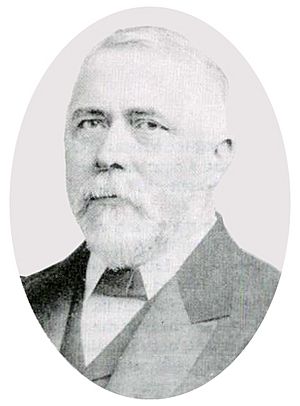William Henry White facts for kids
Quick facts for kids
Sir William White
|
|
|---|---|

Sir William Henry White
|
|
| Born |
William Henry White
2 February 1845 |
| Died | 27 February 1913 (aged 68) London
|
| Nationality | English |
| Education | Royal School of Naval Architecture |
| Occupation | Engineer |
| Engineering career | |
| Discipline | Civil, Marine |
| Institutions | Institution of Civil Engineers (president), Institution of Mechanical Engineers (president), Institution of Marine Engineers (president) |
| Projects | Royal Sovereign-class battleships King Edward VII-class battleships Royal Yacht HMY Victoria and Albert passenger liner RMS Mauretania |
Sir William Henry White (2 February 1845 – 27 February 1913) was a very talented British designer of warships. He held an important job as the Chief Constructor at the Admiralty, which was in charge of the Royal Navy. He designed many important ships during his career.
Contents
Early Life and Training
William Henry White was born in Devonport, England, in 1845. His father, Robert White, worked with leather.
In 1859, William started an apprenticeship at the naval dockyard there. This means he learned a trade by working alongside experienced people.
In 1863, he won a scholarship. This allowed him to study at the new Royal School of Naval Architecture in South Kensington, London.
Career at the Admiralty
After finishing his studies, White started working for the Admiralty. He helped with plans and calculations for new ships. He became an assistant to the main ship designer, Edward James Reed.
In 1872, he became the secretary for the Council of Construction. This group helped manage how all Royal Navy ships were built. From 1872 to 1873, he worked at the Pembroke and Portsmouth Dockyards.
In 1875, he was promoted to Assistant Constructor. He left the Admiralty in 1883 to work for Sir William Armstrong's company. There, he designed and managed the building of warships.
White returned to the Admiralty in 1885. He became the main person in charge of designing naval ships. He was also the Assistant Controller of the Navy.
He quickly helped to reorganize the dockyards and technical departments. He then worked on designing new and important battleships. These were called the Royal Sovereign-class battleships. He was recognized for his work and was knighted in 1895.
Challenges and Retirement
In 1901, Sir William faced some difficulties. There was criticism in Parliament about the royal yacht, Victoria and Albert. The yacht nearly tipped over when it was first launched in 1900.
This happened because too much weight was placed high up on the ship. This included a lot of heavy cement used for soundproofing. Even though he was not directly blamed, the Admiralty felt he should have made sure his team understood the risks better.
He submitted his last design for a battleship, the King Edward VII class, in April 1901. However, he became unwell and worried a lot. He found it hard to let others make small decisions. He asked to retire early and left the Admiralty in 1902.
Legacy and Later Life
During his 16 years as head of naval construction, Sir William White was responsible for designing many ships. He oversaw the design of 43 battleships, 26 armoured cruisers, 102 protected cruisers, and 74 unarmoured warships. This was a total of 245 ships.
After retiring, he worked as a consultant for the design of the Cunard passenger liner RMS Mauretania. He also served as president for several important engineering groups. These included the Institution of Civil Engineers and the Institution of Mechanical Engineers.
He was also a governor of Imperial College from 1907 until his death. Sir William Henry White passed away in London in 1913.
Images for kids



